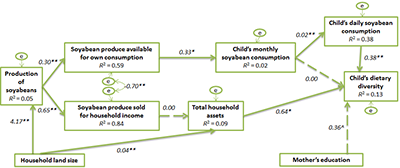In contrast to my first PhD period within the N2Africa project, last year I spent most of my time behind my desk analysing data, discussing results with others and writing. I hope to soon share with you my first paper ‘Child’s nutritional benefits of improved grain legume cultivation in smallholder farming households in rural Ghana and Kenya’.
| As shared earlier, we found no association between N2Africa and nutritional outcomes (legume consumption and individual dietary diversity) of Ghanaian and Kenyan infants and young children. Although overall grain legumes (especially soyabean) were cultivated by a greater fraction of the N2Africa households in both Ghana and Kenya, the total household production of grain legumes did not differ between the N2Africa and non-N2Africa households. As improved nutrition outcomes by N2Africa depend on the level of total household legume production, we combined the data from the non-N2Africa group and the N2Africa group and further explored the production-own consumption and income-food purchase pathway for soyabean in Ghana and Kenya. In Kenya but not in Ghana, we observed a positive effect of soyabean production on child’s dietary diversity through the production-own consumption pathway (Figure 1). |
Values are unstandardized regression coefficients (^P<0.10, *P<0.05, **P<0.01, path coefficients not significantly different from zero are shown by broken lines). Value between error terms of soyabean yield available for own consumption and for household income is the estimated correlation. Part of the variance explained by the model (R2) is given under the variable names. Figure 1. Explorative structural equation model of the effect of soyabean production on dietary diversity of children 6-59 months through production-own consumption pathway and income-food purchase pathway in rural western Kenya (n=197) |
The different findings in Ghana and Kenya suggest the importance of context characteristics. The study shows that a context where (a) farmers attribute positive characteristics towards the targeted nutritious food, (b) a wide variety of local dishes already include the promoted food, (c) women are involved, (d) the targeted nutritious food is a new crop and a food crop, a project like N2Africa has more potential to indirectly improve child’s dietary diversity through the production-own consumption pathway. In Ghana and Kenya, we found no effect through the income-food purchase pathway.
Currently, I am analysing whether household food production supports household and child’s nutrition needs and food-based dietary guidelines in northern Ghana. Household production used for own consumption has the potential to cover the macronutrient (except fat), but not the micronutrient needs. Existing nutrient and food gaps may give direction to which crops need further production investment or improved market availability for affordable prices.
Last June, I attended the Agriculture Nutrition and Health Academy (ANH) Week in Addis Ababa, Ethiopia. This week included interesting relevant practical workshops and I talked with many researchers working on agriculture and food systems for improved nutrition and health. It was great to share my own research results with others and place them in a wider context.
Ilse de Jager, Wageningen University, The Netherlands (Click here for her 2015 update)

